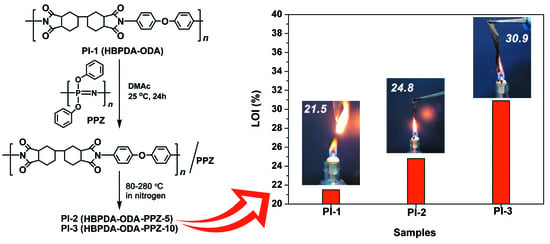Enhancement of Flame Retardancy of Colorless and Transparent Semi-Alicyclic Polyimide Film from Hydrogenated-BPDA and 4,4?-oxydianiline via the Incorporation of Phosphazene Oligomer
Abstract
:1. Introduction
2. Materials and Methods
2.1. Materials
2.2. Characterization Methods
2.3. PI Synthesis and Film Preparation
3. Results and Discussion
3.1. PI synthesis and Film Preparation
3.2. Optical Properties
3.3. Thermal Properties
3.4. Combustion Properties
4. Conclusions
Author Contributions
Funding
Acknowledgments
Conflicts of Interest
References
- Ni, H.J.; Liu, J.G.; Wang, Z.H.; Yang, S.Y. A review on colorless and optically transparent polyimide films: Chemistry, process and engineering applications. J. Ind. Eng. Chem. 2015, 28, 16–27. [Google Scholar] [CrossRef]
- Zhang, X.M.; Song, Y.Z.; Liu, J.G.; Yang, S.Y. Synthesis and properties of cost-effective light-color and highly transparent polyimide films from fluorine-containing tetralin dianhydride and aromatic diamines. J. Photopolym. Sci. Technol. 2016, 29, 31–38. [Google Scholar] [CrossRef] [Green Version]
- Tsai, C.L.; Yen, H.J.; Liou, G.S. Highly transparent polyimide hybrids for optoelectronic applications. React. Funct. Polym. 2016, 108, 2–30. [Google Scholar] [CrossRef]
- Bae, W.J.; Kovalev, M.K.; Kalinina, F.; Kim, M.; Cho, C.K. Towards colorless polyimide/silica hybrids for flexible substrates. Polymer 2016, 105, 124–132. [Google Scholar] [CrossRef]
- Spechler, J.A.; Koh, T.W.; Herb, J.T.; Rand, B.P.; Arnold, C.B. A transparent, smooth, thermally robust, conductive polyimide for flexible electronics. Adv. Funct. Mater. 2015, 48, 7428–7434. [Google Scholar] [CrossRef]
- Kim, Y.M.; Song, C.H.; Kwak, M.G.; Ju, B.K.; Kim, J.W. Flexible touch sensor with finely patterned Ag nanowires buried at the surface of a colorless polyimide film. RSC Adv. 2015, 5, 42500–42505. [Google Scholar] [CrossRef]
- Kang, S.B.; Kim, H.J.; Noh, Y.J.; Na, S.I.; Kim, H.K. Face-to-face transferred multicrystalline ITO films on colorless polyimide substrates for flexible organic solar cells. Nano Energy 2015, 11, 179–188. [Google Scholar] [CrossRef]
- Choi, S.J.; Kim, S.J.; Jang, J.S.; Lee, J.H.; Kim, I.D. Silver nanowire embedded colorless polyimide heater for wearable chemical sensors: Improved reversible reaction kinetics of optically reduced graphene oxide. Small 2016, 12, 5826–5835. [Google Scholar] [CrossRef]
- Wu, X.; Liu, J.G.; Jiang, G.L.; Zhang, Y.; Guo, C.Y.; Zhang, Y.J.; Qi, L.; Zhang, X.M. Highly transparent preimidized semi-alicyclic polyimide varnishes with low curing temperatures and desirable processing viscosities at high solid contents: Preparation and applications for LED chip passivation. J. Mater. Sci. Mater. Electron. 2019, 30, 549–560. [Google Scholar] [CrossRef]
- Choi, I.H.; Chang, J.H. Colorless polyimide nanocomposite films containing hexafluoroisopropylidene group. Polym. Adv. Technol. 2011, 22, 682–689. [Google Scholar] [CrossRef]
- Kim, S.D.; Kim, S.Y.; Chung, I.S. Soluble and transparent polyimides from unsymmetrical diamine containing two trifluoromethyl groups. J. Polym. Sci. Part A Polym. Chem. 2013, 51, 4413–4422. [Google Scholar] [CrossRef]
- Tapaswi, P.K.; Choi, M.C.; Nagappan, S.; Ha, C.S. Synthesis and characterization of highly transparent and hydrophobic fluorinated polyimides derived from perfluorodecylthio substituted diamine monomers. J. Polym. Sci. Part A Polym. Chem. 2015, 53, 479–488. [Google Scholar] [CrossRef]
- Hasegawa, M.; Hirano, D.; Fujii, M.; Haga, M.; Takezawa, E.; Yamaguchi, S.; Ishikawa, A.; Kagayama, T. Solution-processable colorless polyimides derived from hydrogenated pyromellitic dianhydride with controlled steric structure. J. Polym. Sci. Part A Polym. Chem. 2013, 51, 575–592. [Google Scholar] [CrossRef]
- Hasegawa, M.; Horiuchi, M.; Kumakura, K.; Koyama, J. Colorless polyimides with low coefficient of thermal expansion derived from alkyl-substituted cyclobutanetetracarboxylic dianhydrides. Polym. Int. 2014, 63, 486–500. [Google Scholar] [CrossRef]
- Kobayashi, Y.; Fujiwara, Y.; Kitaoka, T.; Oishi, Y.; Shibasaki, Y. Synthesis of highly transparent poly (amide–imide) s based on trimellitic acid and dependence of thermal properties on monomer sequence. React. Funct. Polym. 2016, 108, 78–85. [Google Scholar] [CrossRef]
- Hasegawa, M. Development of solution-processable, optically transparent polyimides with ultra-low linear coefficients of thermal expansion. Polymers 2017, 9, 520. [Google Scholar] [CrossRef]
- Zhang, X.M.; Liu, J.G.; Yang, S.Y. A review on recent progress of R&D for high-temperature resistant polymer dielectrics and their applications in electrical and electronic insulation. Rev. Adv. Mater. Sci. 2016, 46, 22–38. [Google Scholar]
- Fan, H.B.; Yang, R.J. Flame-retardant polyimide cross-linked with polyhedral oligomeric octa (aminophenyl) silsesquioxane. Ind. Eng. Chem. Res. 2013, 52, 2493–2500. [Google Scholar] [CrossRef]
- Lin, C.H.; Chang, S.L.; Cheng, P.W. Soluble high-Tg polyetherimides with good flame retardancy based on an asymmetric phosphinated etherdiamine. J. Polym. Sci. Part A Polym. Chem. 2011, 49, 1331–1340. [Google Scholar] [CrossRef]
- Ando, S.; Matsuura, T.; Sasaki, S. Coloration of aromatic polyimides and electronic properties of their source materials. Polym. J. 1997, 29, 69–76. [Google Scholar] [CrossRef] [Green Version]
- Zhang, Q.; Tsai, C.Y.; Li, L.J.; Liaw, D.J. Colorless-to-colorful switching electrochromic polyimides with very high contrast ratio. Nat. Commun. 2019, 10, 1239. [Google Scholar] [CrossRef] [PubMed]
- Hasegawa, M.; Horie, K. Photophysics, photochemistry, and optical properties of polyimides. Prog. Polym. Sci. 2001, 26, 259–335. [Google Scholar] [CrossRef]
- Morgan, A.B. The future of flame retardant polymers—Unmet needs and likely new approaches. Polym. Rev. 2019, 59, 25–54. [Google Scholar] [CrossRef]
- Tolando, R.; Zanovello, A.; Ferrara, R.; Iley, J.N.; Manno, M. Inactivation of rat liver cytochrome P450 (P450) by N,N-dimethylformamide and N,N-dimethylacetamide. Toxicol. Lett. 2001, 124, 101–111. [Google Scholar] [CrossRef]
- Lu, S.Y.; Hamerton, I. Recent developments in the chemistry of halogen-free flame retardant polymers. Prog. Polym. Sci. 2002, 27, 1661–1772. [Google Scholar] [CrossRef]
- Velencoso, M.M.; Battig, A.; Markwart, J.C.; Schartel, B.; Wurm, F.R. Molecular firefighting—How modern phosphorus chemistry can help solve the challenge of flame retardancy. Angew. Chem. Int. Ed 2018, 57, 10450–10467. [Google Scholar] [CrossRef] [Green Version]
- Mayer-Gall, T.; Knittel, D.; Gutmann, J.S.; Opwis, K. Permanent flame retardant finishing of textiles by allyl-functionalized polyphosphazenes. ACS Appl. Mater. Interfaces 2015, 7, 9349–9363. [Google Scholar] [CrossRef]
- Salmeia, K.A.; Gaan, S.; Malucelli, G. Recent advances for flame retardancy of textiles based on phosphorus chemistry. Polymers 2016, 8, 319. [Google Scholar] [CrossRef] [Green Version]
- Huang, W.K.; Chen, K.J.; Yeh, J.T.; Chen, K.N. Curing and combustion properties of a PU-coating system with UV-reactive phosphazene. J. Appl. Polym. Sci. 2002, 85, 1980–1991. [Google Scholar] [CrossRef]
- Kabisch, B.; Fehrenbacher, U.; Kroke, E. Hexamethoxycyclotriphosphazene as a flame retardant for polyurethane foams. Fire Mater. 2014, 38, 462–473. [Google Scholar] [CrossRef]
- Honarkar, H.; Rahimi, A. Applications of Inorganic Polymeric Materials, III: Polyphosphazenes. Monatsh. Chem. 2007, 138, 923–933. [Google Scholar] [CrossRef]
- Gleria, M.; Bolognesi, A.; Porzio, W.; Catellani, M.; Destri, S.; Audisio, G. Grafting reactions onto poly (organophosphazenes). I. The case of poly [bis(4-isopropylphenoxy) phosphazene-g-polystyrene copolymers. Macromolecules 1987, 20, 469–473. [Google Scholar] [CrossRef]
- Lejeune, N.; Dez, I.; Jaffres, P.A.; Lohier, J.F.; Madec, P.J.; Santos, J.S.O. Synthesis, crystal structure and thermal properties of phosphorylated cyclotriphosphazenes. Eur. J. Inorg. Chem. 2018, 2018, 138–143. [Google Scholar] [CrossRef]
- Zanini, S.; Riccavdi, C.; Orlandi, M.; Colombo, C.; Croccolo, F. Plasma-induced graft-polymerisation of ethylene glycol methacrylate phosphate on polyethylene films. Polym. Degrad. Stab. 2008, 93, 1158–1163. [Google Scholar] [CrossRef]
- Tang, C.; Yan, H.X.; Li, M.N.; Lv, Q. A novel phosphorus-containing polysiloxane for fabricating high performance electronic material with excellent dielectric and thermal properties. J. Mater. Sci. Mater. Electron. 2018, 29, 195–204. [Google Scholar] [CrossRef]
- Qian, L.J.; Ye, L.J.; Xu, G.Z.; Liu, J.; Guo, J.Q. The non-halogen flame retardant epoxy resin based on a novel compound with phosphaphenanthrene and cyclotriphosphazene double functional groups. Polym. Degrad. Stab. 2011, 96, 1118–1124. [Google Scholar] [CrossRef]
- Schartel, B.; Hull, T.R. Development of fire-retarded materials-Interpretation of cone calorimeter data. Fire Mater. 2007, 31, 327–354. [Google Scholar] [CrossRef]
- Qiu, S.; Wang, X.; Yu, B.; Feng, X.; Mu, X.; Yuen, R.K.K.; Hu, Y. Flame-retardant-wrapped polyphosphazene nanotubes: A novel strategy for enhancing the flame retardancy and smoke toxicity suppression of epoxy resins. J. Hazard. Mater. 2017, 325, 327–339. [Google Scholar] [CrossRef]
- Yan, Y.W.; Chen, L.; Jian, R.K.; Kong, S.; Wang, Y.Z. Intumescence: An effect way to flame retardance and smoke suppression for polystyrene. Polym. Degrad. Stab. 2012, 97, 1423–1431. [Google Scholar] [CrossRef]
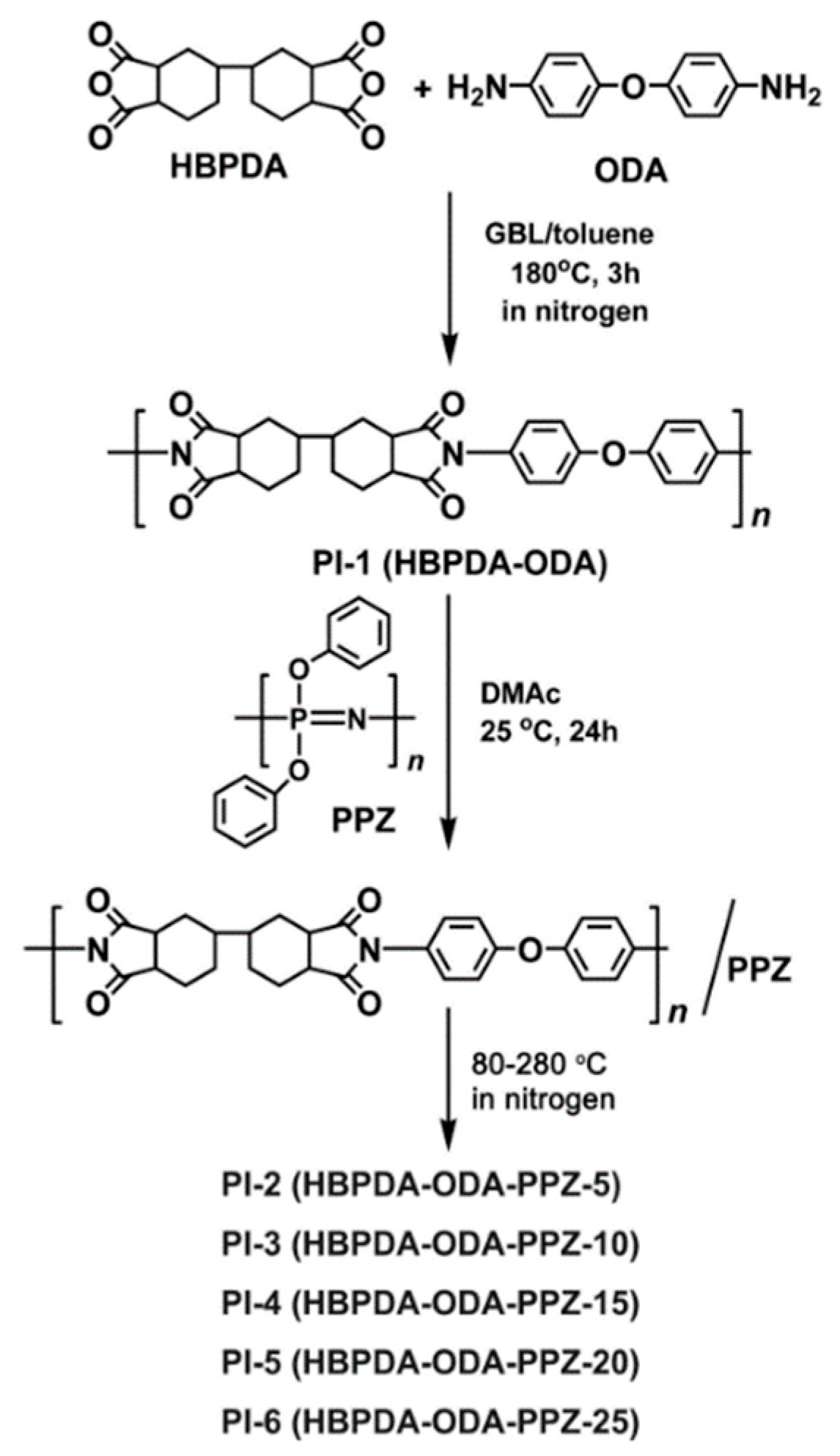
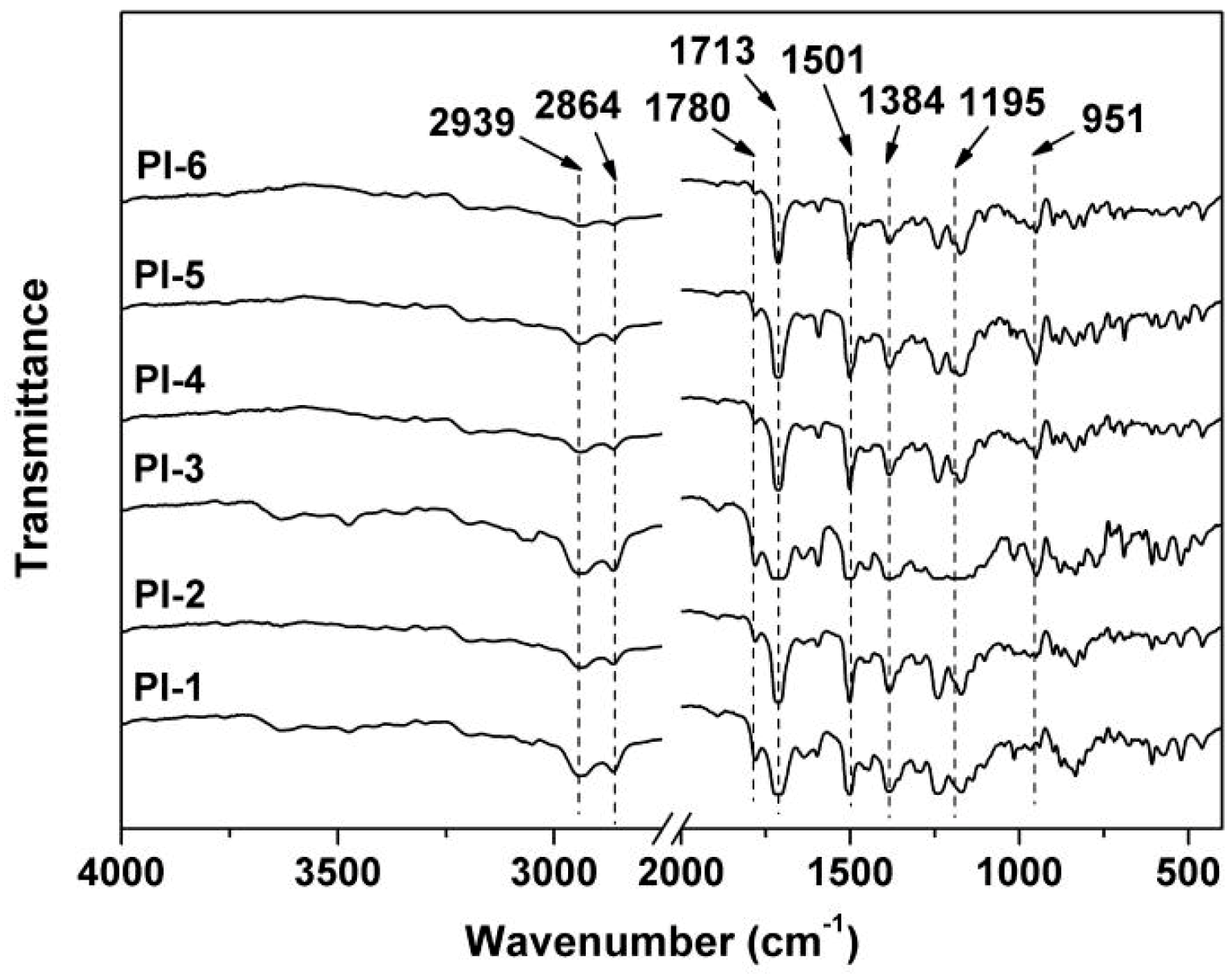
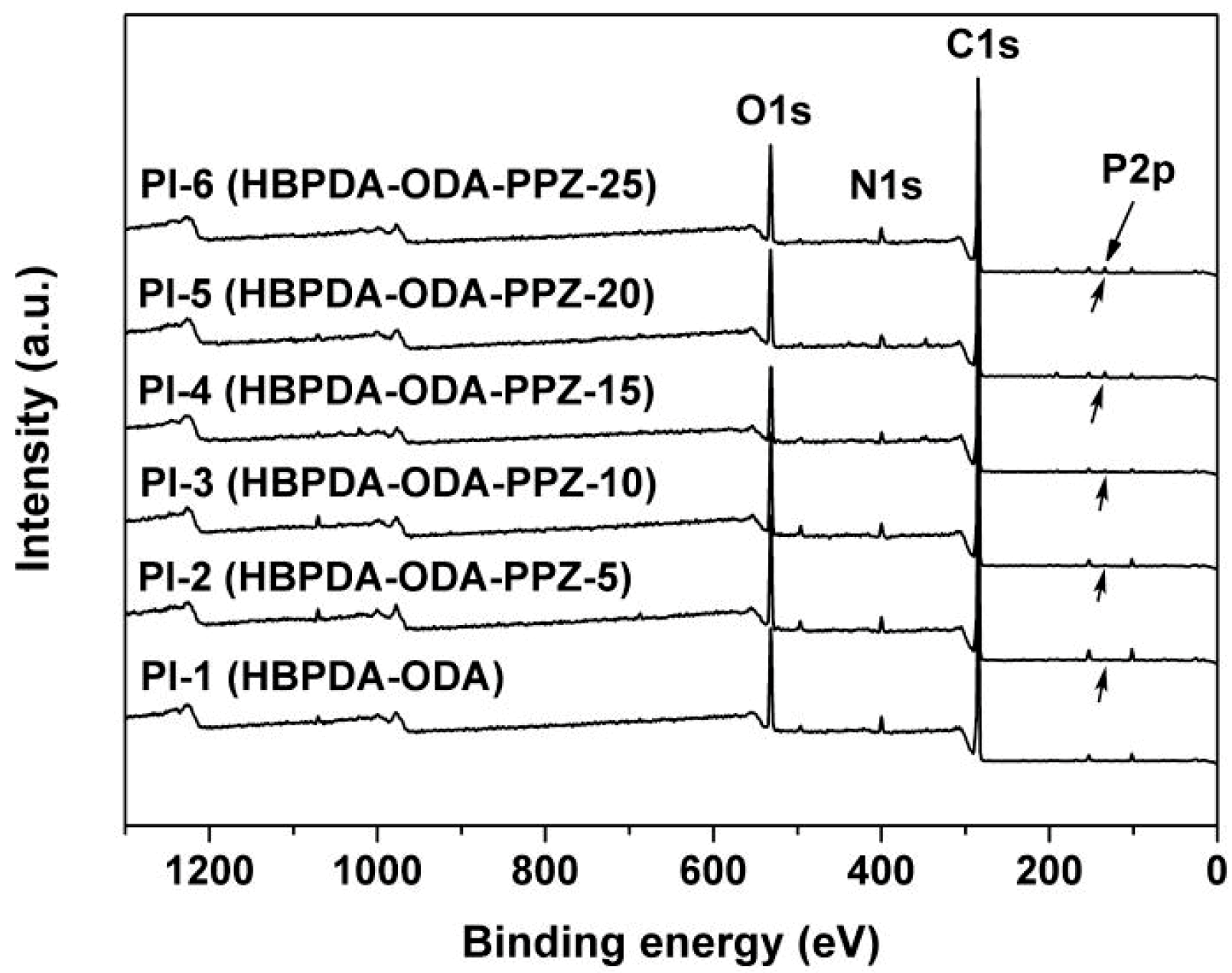

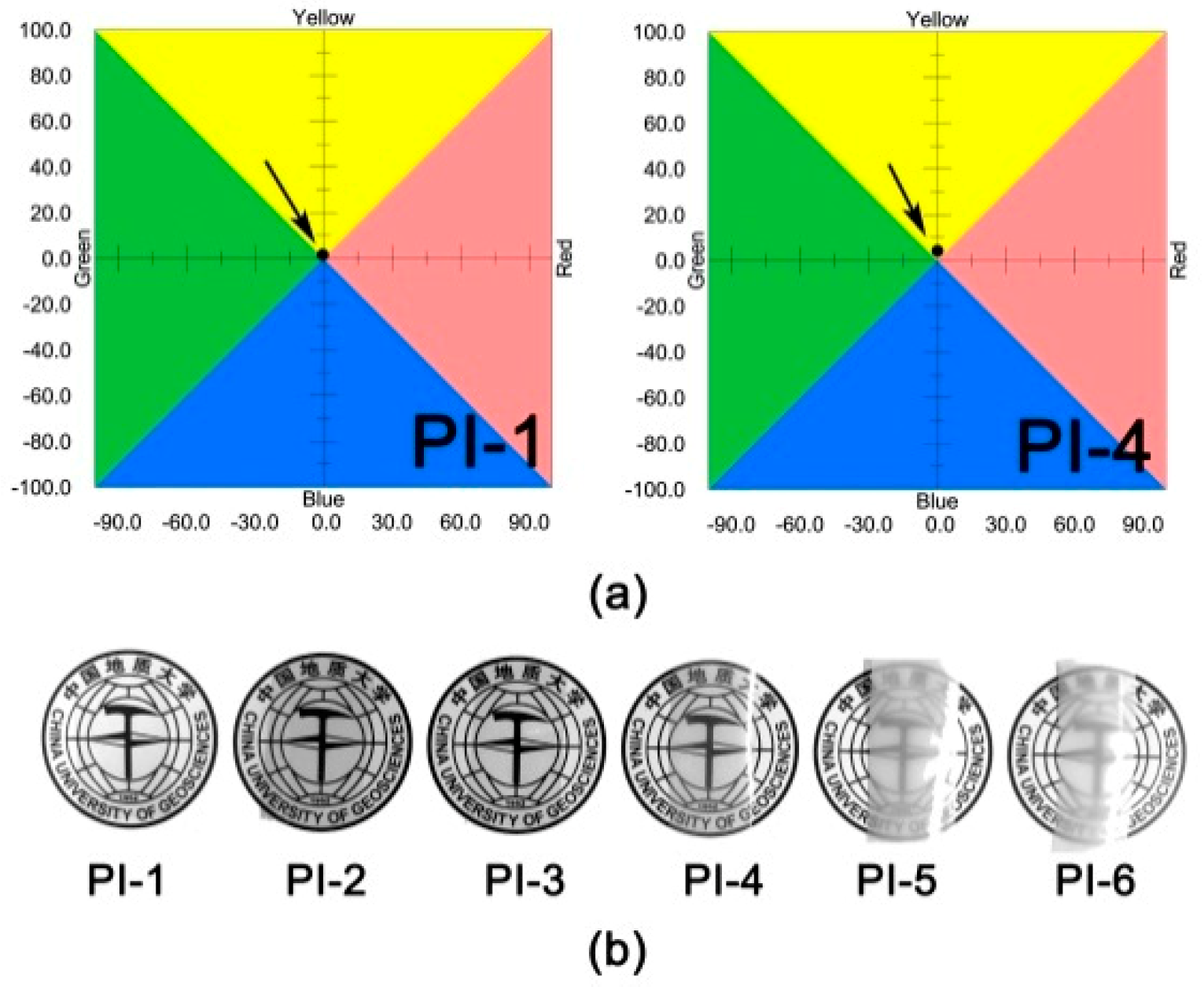

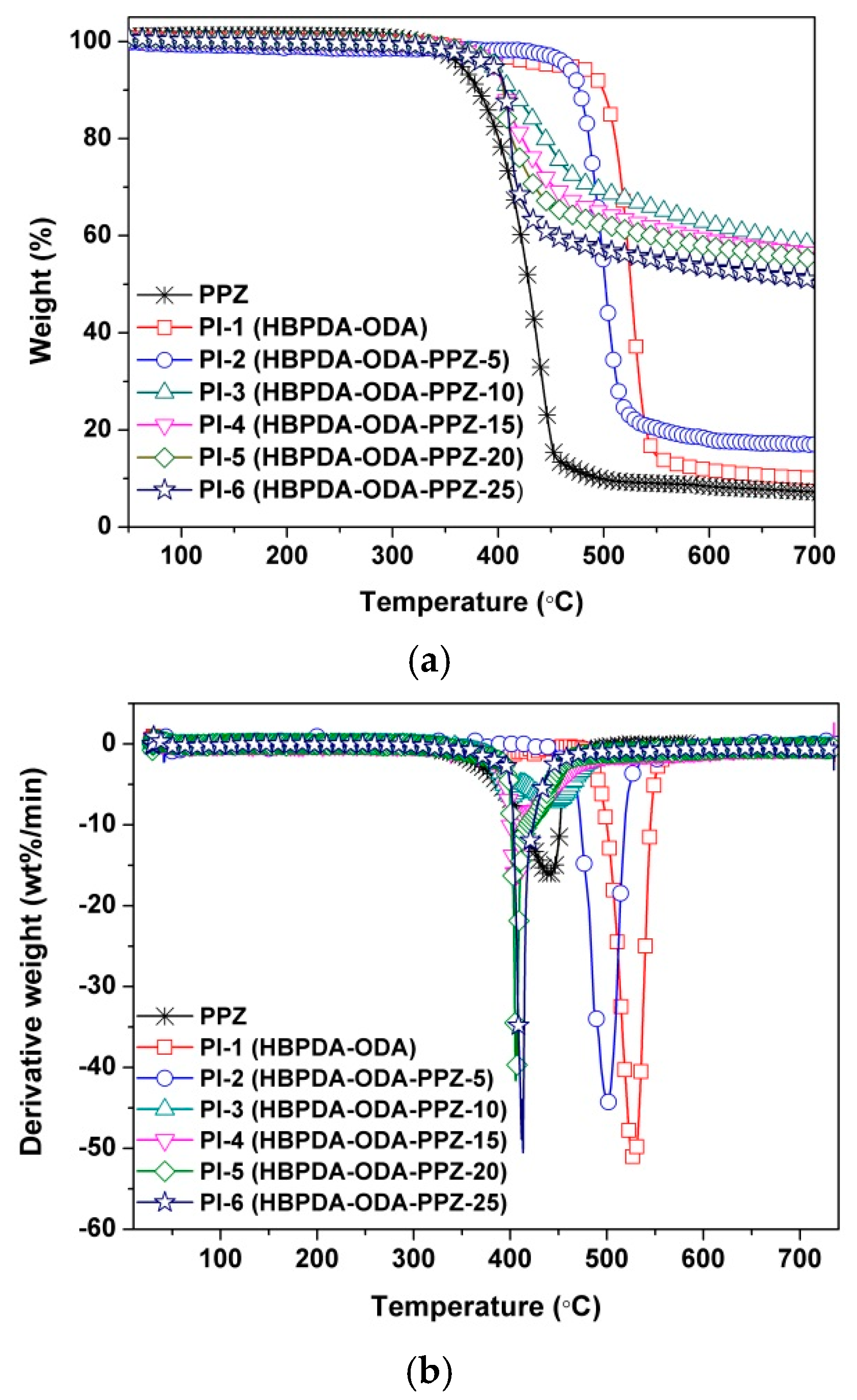

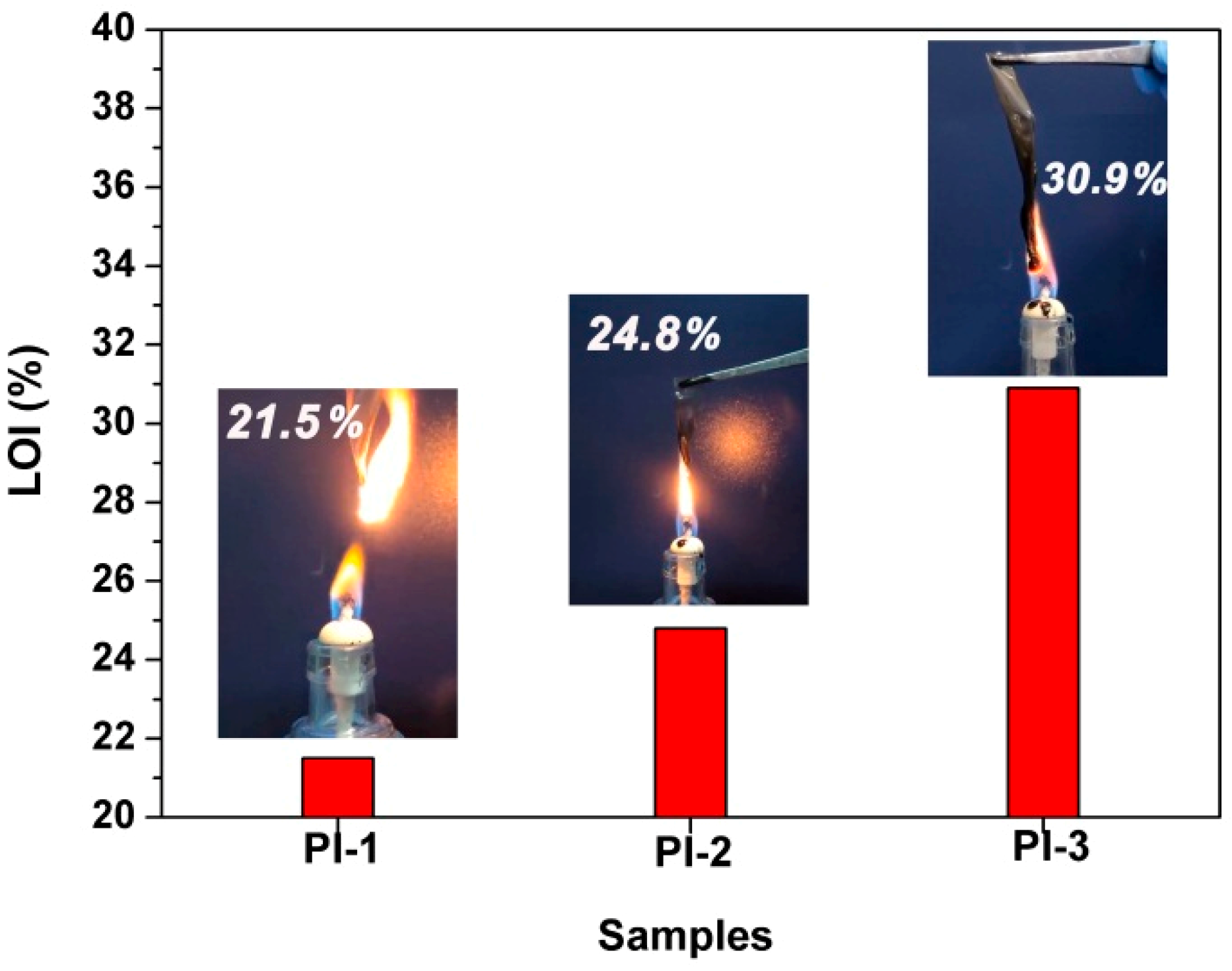


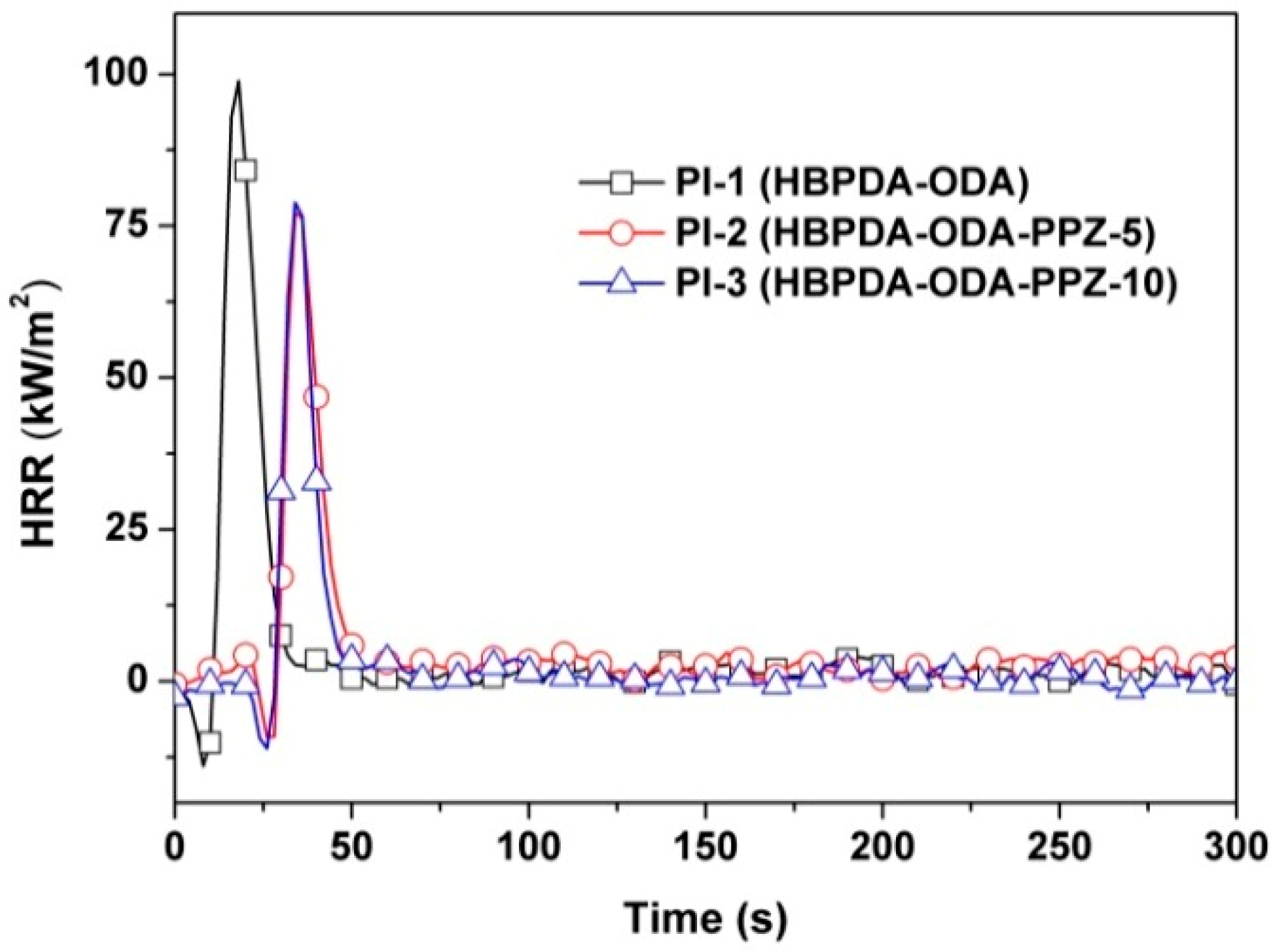
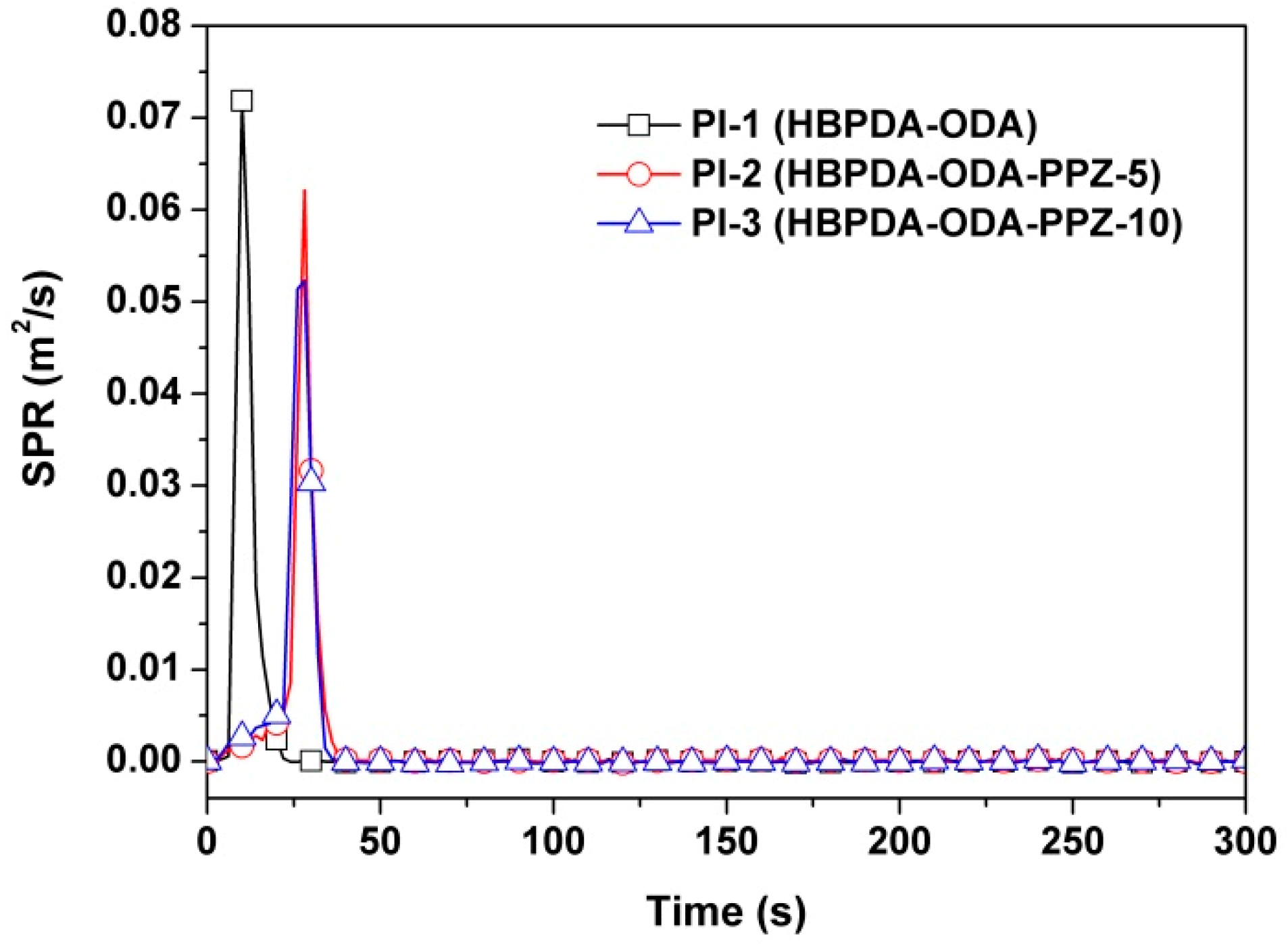


| PI | PPZ (wt.%) | λ (nm) a | T450 (%) b | L* c | a* c | b* c | Haze |
|---|---|---|---|---|---|---|---|
| PI-1 | 0 | 291 | 83.6 | 96.11 | −0.23 | 2.57 | 1.21 |
| PI-2 | 5 | 292 | 81.1 | 95.10 | −0.54 | 4.21 | 3.79 |
| PI-3 | 10 | 294 | 75.0 | 94.87 | −0.27 | 3.56 | 5.03 |
| PI-4 | 15 | 295 | 27.2 | 92.37 | 0.16 | 4.15 | 27.67 |
| PI-5 | 20 | 295 | 9.5 | 87.95 | 0.11 | 3.42 | 93.83 |
| PI-6 | 25 | 298 | 1.1 | 86.98 | 0.09 | 4.65 | 100.00 |
| Samples | PPZ (wt.%) | Tg (°C) a | T10% (°C) b | Tmax (°C) b | Rw700 (%) c |
|---|---|---|---|---|---|
| PPZ | 100 | ND d | 381.3 | 438.2 | 8.2 |
| PI-1 | 0 | 260.6 | 487.3 | 527.7 | 10.0 |
| PI-2 | 5 | 244.8 | 470.2 | 501.7 | 17.1 |
| PI-3 | 10 | 227.4 | 411.6 | 448.9 | 58.3 |
| PI-4 | 15 | 220.9 | 405.5 | 413.2 | 56.3 |
| PI-5 | 20 | 219.8 | 405.1 | 407.1 | 55.2 |
| PI-6 | 25 | 207.3 | 406.6 | 405.0 | 50.8 |
| PI | UL 94 | t1 (s) | t2 (s) | t1 + t2 (s) | Dripping a | Ignition b | LOI c (%) | THR d (MJ/m2) | pHRR e (kW/m2) |
|---|---|---|---|---|---|---|---|---|---|
| PI-1 | Not VTM-2 | ND f | ND | ND | Yes | Yes | 21.5 | 1.45 | 98.9 |
| PI-2 | VTM-0 | 11 | 8 | 19 | No | No | 24.8 | 1.48 | 77.3 |
| PI-3 | VTM-0 | 15 | 0 | 15 | No | No | 30.9 | 0.99 | 76.6 |
© 2020 by the authors. Licensee MDPI, Basel, Switzerland. This article is an open access article distributed under the terms and conditions of the Creative Commons Attribution (CC BY) license (http://creativecommons.org/licenses/by/4.0/).
Share and Cite
Wu, X.; Jiang, G.; Zhang, Y.; Wu, L.; Jia, Y.; Tan, Y.; Liu, J.; Zhang, X. Enhancement of Flame Retardancy of Colorless and Transparent Semi-Alicyclic Polyimide Film from Hydrogenated-BPDA and 4,4?-oxydianiline via the Incorporation of Phosphazene Oligomer. Polymers 2020, 12, 90. https://doi.org/10.3390/polym12010090
Wu X, Jiang G, Zhang Y, Wu L, Jia Y, Tan Y, Liu J, Zhang X. Enhancement of Flame Retardancy of Colorless and Transparent Semi-Alicyclic Polyimide Film from Hydrogenated-BPDA and 4,4?-oxydianiline via the Incorporation of Phosphazene Oligomer. Polymers. 2020; 12(1):90. https://doi.org/10.3390/polym12010090
Chicago/Turabian StyleWu, Xiao, Ganglan Jiang, Yan Zhang, Lin Wu, Yanjiang Jia, Yaoyao Tan, Jingang Liu, and Xiumin Zhang. 2020. "Enhancement of Flame Retardancy of Colorless and Transparent Semi-Alicyclic Polyimide Film from Hydrogenated-BPDA and 4,4?-oxydianiline via the Incorporation of Phosphazene Oligomer" Polymers 12, no. 1: 90. https://doi.org/10.3390/polym12010090
APA StyleWu, X., Jiang, G., Zhang, Y., Wu, L., Jia, Y., Tan, Y., Liu, J., & Zhang, X. (2020). Enhancement of Flame Retardancy of Colorless and Transparent Semi-Alicyclic Polyimide Film from Hydrogenated-BPDA and 4,4?-oxydianiline via the Incorporation of Phosphazene Oligomer. Polymers, 12(1), 90. https://doi.org/10.3390/polym12010090





